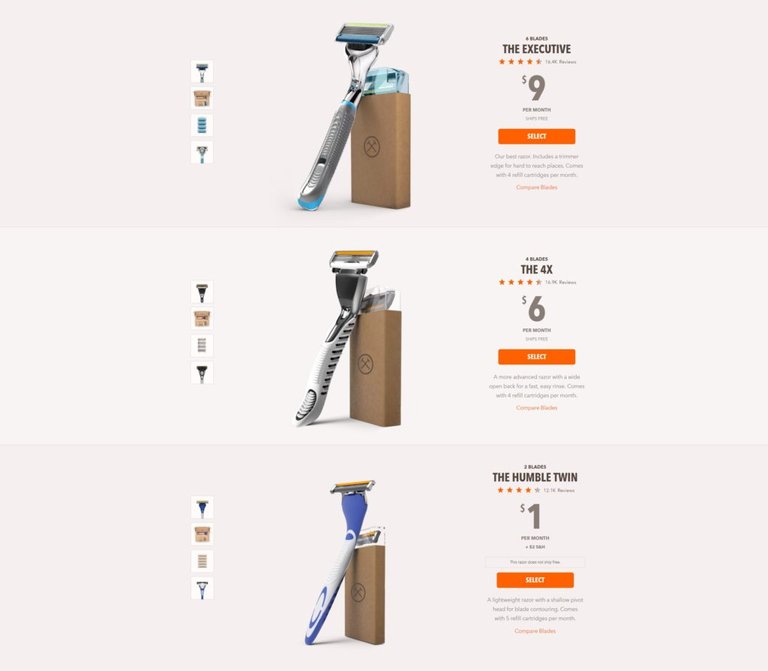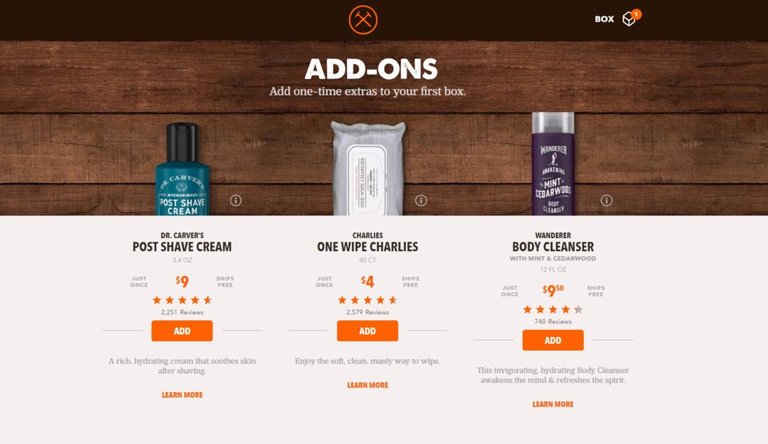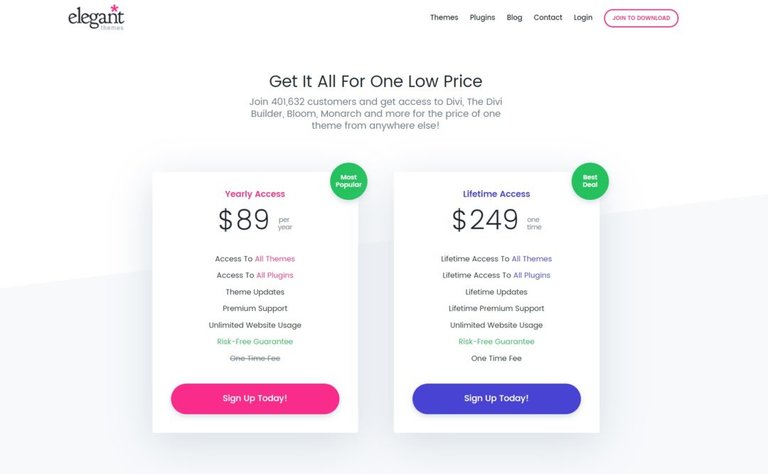It seems like there are a decent number of entrepreneurs here on steemit, so I wanted to share this here for those interested.
I'm a freelancer who earns my bitcoin from writing and marketing, and after focusing on packaging and upselling my services beginning last December, I've earned as much in the last 5 months as I did through the entirety of 2016. Let me know what you think, and if this is helpful, I'll post more stuff here on steemit.
-----------
Why Upselling Is Magic & Your Clients Will Thank You For Taking Their Money
Who is the easiest person in the world to sell to?
Someone who is already paying you money.
And while that might seem like a fairly common sense assumption, we don’t need to speculate or assume. The statistics back it up:
- Existing customers are 50% more likely to try a new product/service.
- Existing customers will pay 31% more for new products/services.
But here’s the deal.
Not only is it easier to sell to your existing customers, but there’s actually a way to make them overjoyed to hand you more money.
It’s called upselling, and it’s f**king magic.
How magical are we talking?
Thanks to upselling, I’ve earned more in the last 5 months than I earned through the entirety of 2016.
Have you ever heard the phrase “taking candy from a baby”?
Upselling is like having a busload of giggling babies throw candy at you repeatedly and then thank you for eating it.Let’s talk specifics.
The Big Reason Upselling Works
In a typical scenario, people aren’t actively looking to give away more of their money.
At least, not anybody I know.
So how does upselling change that?
When done correctly, upselling connects a problem people are actively trying to solve with a solution provider they are already happy with.
It’s sort of like if you were looking to buy a used car and found out the trusted mechanic you’ve been going to for 20 years had expanded his business into a small used car dealership. You’d be thrilled!
You’ve already built trust with this guy. You already know he does flawless work. And now he’s saving you the risk and hassle of sourcing your own deal on craigslist or overpaying at a big dealership.
You can’t wait to throw some coin at him.

That’s upselling.
One of the biggest obstacles in ecommerce is trust.
How do I know that _____ business or _____ service provider will give me what they say they’ll give me – at the quality they are promising – when I send them my money?
- Finding exceptional writers is a pain in the ass.
- Finding talented designers is a pain in the ass.
- Finding developers who meet deadlines is a pain in the ass.
- Finding intuitive software that does what you need is a pain in the ass.
- Finding quality products that aren’t overpriced is a pain in the ass.
- Finding ______ is a pain in the ass.
My ass hurts. Your ass hurts.
With upselling, we can shorten the time span between purchasing new office chairs.
Upselling eliminates all the hassle that comes with finding a new product or service provider. And that’s why, when done correctly, having someone upsell you is a bigass convenience.
By that’s enough talk about donkeys, let’s dive into the specifics of upselling. It’s going to be a bit different for services versus products, so we’re going to start with the former and end with the latter.
3 Ways To Upsell Your Services
Whether you’re a freelancer, agency, or firm, I encourage every level of service provider to offer their services through the lens of consulting. You may be hired for a specific skillset, but there’s a lot of expertise and application surrounding that service that can greatly enhance the value you offer.
Let’s use my own business as an example.I’m a writer. I can write a page of copy or draft an interesting blog post. At one point in my career, I’d charge around $200 to deliver that service. Nowadays, I can charge $2,000+ to write a blog post.
Why?
Is my blog writing 10x better than it used to be? Not exactly.
My skills have certainly improved over time, but the reason I can charge so much more is that when someone hires me as a writer, they are really hiring a content marketing consultant.
I can tell them why their current content marketing isn’t getting an ROI. I can ideate topics that get tons of traction with their target audience. I can even help them define their target audience if they haven’t already. I can create posts that are better than anything their competitors are doing. I can get those posts ranked on Google’s front page for their target SEO keyphrases. And so on and so forth.
Yes, I’m writing a post, but I’ve developed my expertise to the point where my value far outweighs the simple action of writing a blog post.

On a scale of 0-10, how many fingernails do you think I’ll have to pull to upsell this client?
Magic.
When you look to upsell your current service, using the following three methods, you’ll quickly identify ways to expand your value and develop your expertise.
1. Provide A Higher Quality Version Of Your Current Work
Do you want Option #A, Option #B, or Option #C?
Even if someone is sure they want to work with you, 9 times out of 10, they will choose to start at the lowest available price point.
This goes back to that trust hurdle. They might be willing to spend $3,000 on your services, but if they can dip their toe in the water for $500, that’s what they are typically going to do.
This means that many of your current clients are actually willing to pay you more for an increased quality or scope of work. If they like what you are doing, and you can provide a bigger, better version that provides them with a higher ROI, they will very frequently be happy to upgrade their service.
I had one client who was paying me to create strategic content pieces at 1,750 words a piece. The client had targeted me specifically based on my previous work and loved what I was producing for them. I knew that longer content would be a better fit for their strategy, so I advised them to double the length of their content.
They were happy to pay me double the rate for the longer pieces, and the more in-depth strategy took them from $100k MRR to $300k MRR in less than a year.
2. Take Additional Responsibilities Off Your Client’s Plate
When a business is growing, convenience can come at a massive premium. Successful owners and managers prefer to focus on one or two key areas that play to their strengths and then delegate everything else.
When someone doesn’t have expertise in a given area, they will happily pay a premium for the ability to ignore the entire area and just have someone who knows what they’re doing handle it. If you can provide a turnkey service that allows your client to be completely hands-free and focus on other things, you can charge more than the sum of the parts you are delivering.
The key is to identify what sort of turnkey service you can provide based on your current client relationship.
For example:
I had one client who was paying me to write articles, but the articles really weren’t providing much of an ROI. The client didn’t have a content marketing system in place to extract the value of the content and had no clue how to build or run such a system.
Accordingly, I upsold the client on a turnkey content marketing service, where I handled strategy, writing, promotion, and link building, and the client didn’t have to do a thing. They were happy to pay a significantly higher rate for me to simply take it off their hands and let them focus on their area of expertise.
And since they had an actual expert working on their content marketing, they doubled their traffic within six months. Win-win.
3. Solve Additional Problems Your Client Is Facing
The first two strategies we’ve discussed today are fairly standard methods for growing a business, particularly a consulting business. All you are doing is taking your existing service and scaling it up.
Sometimes, however, scaling up your current service might not be the best way to go.On one hand, there might not be an “up” to scale into. Your service might be more of a one-off problem solving engagement that can’t really be evolved into anything bigger.
On the other hand, it might not be very lucrative to scale up what you are currently doing. Instead, you might notice that other problems seem to consistently come up for your clients, problems that you can make a lot more money solving or problems that are so frequent, it’s worth your time to learn how to solve them.
Pivoting your business to tackle high-demand problems can be a very effective strategy and can help you kick your business out of a plateau and back into growth.
I began my career solely as a copywriter, focusing primarily on writing copy for landing pages. I noticed that my clients ALWAYS needed someone to write blog posts for them, and the demand was so great, I decided to pivot my business to also take on content marketing.
Whereas the typical copywriting engagement will result in a one-off fee, content marketing gigs offer month-to-month revenue and have a lot of crossover with the copywriting skill set. Writing blog posts also doubles as advertising for my business, so it’s turned out to be a very complementary mix of services.
It’s very likely that there are complimentary needs in your own market that you can quickly expand into, and finding that secondary offer might be the kick in the pants your business needs.
3 Ways To Upsell Products
Upselling products is not a whole lot different from upselling services from a philisophical point of view. The core elements of trust and and problem solving are the exact same.
The only real difference is the examples, so let’s just dive right in.
1. Sell An Upgraded Version Of Your Product
Similar to our first service upsell method, the simplest way to upsell a product is to offer something better at a higher price.
I’m going to use the Dollar Shave Club as an example. Their entire brand and all their marketing is built around this “Dollar” price point, but in reality, they need to make more than that to survive as a business, and deep down, their customers aren’t genuinely unwilling to pay more than $1 per month to shave.
The price isn’t really what it’s important. It’s the pain points being solved, and Dollar Shave Club is solving three big pain points with their service:
- Ridiculously overpriced razor blades
- Low availability of quality, inexpensive razors
- Inconvenience of running out of razor blades
People didn’t flock to Dollar Shave Club because they wanted $1 blades. They came looking for a convenient, quality, reasonably priced shave.
So how does the company bridge the gap between their “Dollar” advertising and their actual bread and butter products?
Upselling.
In addition to the “$1” product, they also offer two higher priced upgrades for customers to choose from.

If customers landed on the pricing page and were only greeted by $6 and $9 blades, they’d be upset. They were promised $1 blades. Since Dollar Shave Club has included that price point, they are delivering on their marketing promises, and now the customer is free to look at the other options and think, “Hmmm $6 per month is like half what I’m paying now, and I’d much rather have a 4-blade razor than a 2-blade razor. Let’s go with that.”
Now, pay attention here, because I don’t want you to miss this.Imagine if this company was called “Half-Priced Shave” or branded itself around the concept of “razor blades for half the price”.
That’s not very compelling. That’s not market disrupting.But practically speaking, it’s exactly what they are doing. Based on the review counts, 73% of their sales are coming from their $6 and $9 models, while barely a fourth are the actual “Dollar” product.
That is 100% by design. Branding is all about positioning yourself around your most compelling value proposition, NOT the most profitable piece in your sales funnel. With upselling, you don’t have to choose between crippling your marketing or crippling your profitability.
And as you’re about to see, this is just the first stop on Dollar Shave Club’s upsell sequence.
2. Sell A Supplemental Product Or Service
What if a customer only wants the lowest priced version of your product? Or what if a customer has already purchased the highest priced version?
Does that mean you’ve maxed out your earnings from that customer?
Hardly.For the vast majority of products, there are other products that make for a natural addition to the purchase. Add toothpaste to a toothbrush sale. Add seasoning to a sauce sale. Add a bedset to a mattress sale.
In Dollar Shave Club’s case, the company immediately follows up blade selection with the following upsell screen:

I don’t know what the company’s margins are on these products, but I’m willing to bet they are significantly higher than the margins on their shaving blades.
It’s the same model that McDonalds used to become a $100 Billion company. They spend $1.91 in marketing to get one customer to the store for a cheeseburger. If they customer orders a $2.09 burger, that’s just $0.18 profit. If the customer orders a dollar menu cheeseburger, that might even be a small loss. BUT THEN they upsell the fries and soda at a $1.14 margin. In the end, 86% of the profit is made from the upsell.
You can do the same thing with a service, which works better for certain business models.Earlier this week, I was looking at Slingshot, a SaaS product from Bryan Harris. The core product costs $750 per year, but if I want Bryan to help me personally launch my product, I can pay $5,000 per month to supplement the product with Brian’s consulting service. That’s a $4,937.50 per month upsell! And based on the “No Spots Available” indicator and my experience following Bryan’s content for 3 years, I guarantee he has every single upsell spot filled.

This isn’t rocket science. I bet you a giggling, candy-throwing baby you can think of a supplemental product or service that could be paired with your core offer in less than 30 seconds of brainstorming.And that’s just the beginning.
3. Sell A Recurring Package
There’s really no hard cap on the number of supplemental products and services you can tack-on to your core product. But no matter how big your sales package becomes, at the end of the day, you still have to go out and sell it again.
This is what makes a recurring sales model so attractive. You make the same sale, but instead of a one-time payout, you get revenue on a recurring basis. This is a big part of why Dollar Shave Club has been able to be so successful. They might only make $2 in profit on their $9 blades, but with a recurring subscription, that’s essentially a $12 per year perpetuity per customer, BEFORE upsells.
But not every product is a good fit for this recurring sales model. And that’s what makes upselling so endlessly magical. With upselling, you don’t need to sell your core product on a recurring basis. You can upsell a different product or service that fits a recurring sales model instead.
A great example of this comes from WordPress developer Elegant Themes, whose products I recently used to redesign my site. When the company first launched, their primary products were individual WordPress themes, but as they continued to develop more and more themes and plugins, they started offering access to all their products as a recurring membership upsell.
Today, they’ve sort of come full circle, eliminating individual theme sales and offering the yearly membership as their primary service. The new upsell is lifetime access for a one-time fee equal to 2.8x the yearly membership price.

This brings up a good point with recurring sales. Customers don’t keep their memberships forever, so every recurring contract has a singular value. You might wonder why Elegant Themes would choose to upsell people from a recurring plan to a one-off fee. Why not just let people stay on your plan for 3+ years and make more money?
I would bet you another giggling, candy-throwing baby that the average lifetime value of an Elegant Themes customers is less than $249. I’m just spitballing here, but I’d guess the average customer membership tends to last around 2 years, which means upselling to $249 represents an immediate 30% increase in revenue per upsold customer.
I can tell you from talking with many entrepreneurs that sometimes recurring sales models are a homerun and other times they are simply unfeasible. You’ll have to crunch the numbers on your own business prospects, but if you can find that product + recurring sale one-two punch, it’s likely to take you places.
Conclusion: Time To Be A Magician
Upselling is marketing magic.
If I had the best words, I might even say it’s covfefe.
Use these strategies to immediately increase your earnings, whether you’re selling a product or a service.
Thanks for the good article
Congratulations @jamd! You received a personal award!
You can view your badges on your Steem Board and compare to others on the Steem Ranking
Vote for @Steemitboard as a witness to get one more award and increased upvotes!